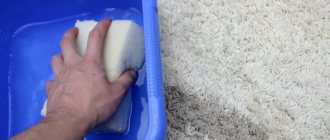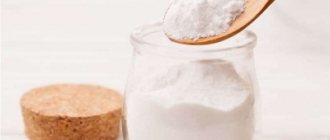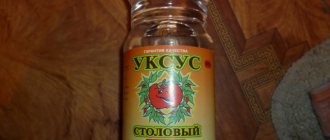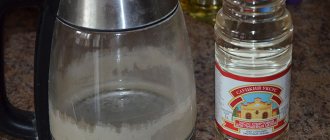If you don’t want to spend money on specialized microwave care products, you can use what you have at hand: soda, salt, citric acid or vinegar. It is the latter that we devoted our review to. You will learn how to easily care for your microwave oven without spending much time and money. How to clean a microwave with vinegar? It's simple: the recipes are listed below.
How to clean a microwave with citric acid
The method copes with medium and heavy dirt.
What do you need:
- microwave-safe bowl;
- 2 glasses of water;
- 1–2 tablespoons of citric acid;
- sponge, cloth or paper towel.
How to do
Pour water into a bowl, add citric acid and stir. Place in the microwave and turn it on at full power for 10 minutes.
After another couple of minutes, open the door, take out the bowl and wipe the inside of the appliance.
What is the secret of vinegar's effectiveness?
Table vinegar perfectly cleans most surfaces. Even stubborn contaminants easily dissolve in an acidic environment.
This universal cleaner will help you deal with many stains without external damage. The advantages of using this tool are as follows:
- Cost-effective and accessible. Vinegar is easy to buy at any store and is inexpensive.
- Environmentally friendly, relatively safe for health. The product does not poison the body and does not pollute the environment. Natural composition reduces the likelihood of allergies.
- Eliminates odors. All extraneous aromas disappear along with vinegar vapor.
- Cleans most organic contaminants. Vinegar breaks down fats, making them soluble in water.
- Surface safety. All microwave coatings, except stainless steel, withstand contact with acetic acid perfectly.
- Kills germs. Vinegar has disinfectant and antifungal properties and works well against mold.
How to clean a microwave with lemon
Citrus will help get rid of not only medium-sized stains, but also unpleasant odors.
What do you need:
- microwave-safe bowl;
- 1–2 glasses of water;
- 1 lemon;
- sponge, cloth or paper towel.
How to do
Pour water into a bowl and dilute the juice of a whole lemon in it. Cut the rest of the fruit and also put it in a container. Heat everything in the microwave at full power for 10-15 minutes. Leave the bowl inside for 5 minutes, then wipe down the oven.
Types of surfaces
Cleaning the outside and inside is significantly different. While the outer surfaces can be wiped with almost anything (meaning a detergent or cleaning agent), it is not recommended to rub the inside of the stove with anything. A particularly careful approach is needed to the reflective coating, which can be made of different materials:
- Stainless steel . Steel copes well with temperature fluctuations, but greasy stains still stick to it. Getting rid of smudges and traces of grease is not so easy. The use of powdered products and acids is excluded: abrasive particles can scratch the stainless steel, and under the influence of acid the coating will darken.
- Enamel . Absolutely smooth and has no pores, so fat is practically not absorbed. In this case, the surface requires accuracy. The use of abrasive agents is unacceptable, and strong mechanical impact is also undesirable - every scratch will subsequently lead to corrosion.
- Ceramics (or BIO-ceramics). The best option for internal camera coating. Such a surface has the properties of steel - strength, and enamel - smoothness. It is recommended to use a sponge or soft cloth for cleaning.
Now we have to figure out which microwave ovens cannot be cleaned using vinegar . This substance is acidic, and acids are dangerous to stainless steel coatings. Therefore, if you have such a microwave oven, look for other budget-friendly cleaning methods in our materials.
How to clean a microwave with vinegar
It is able to remove stubborn plaque, including fatty deposits.
What do you need:
- 3 tablespoons table vinegar;
- microwave-safe bowl;
- 1–1½ glasses of water;
- sponge, cloth or paper towel.
How to do
Before cleaning, it is better to open the window so as not to suffocate from vinegar fumes.
Pour vinegar into a bowl of water. If the contamination is very strong, you can mix the liquids in a 1:1 ratio, for example, ½ glass of water and ½ glass of vinegar. Heat the solution in the microwave for 5–10 minutes at maximum power.
HGTV YouTube channel
Wait 10 minutes before opening the door. After such a vinegar bath, it will be enough to remove the dirt with a sponge.
Properties of vinegar
- What happens in the microwave?
- Why is this liquid so effective?
- How does cleansing work?
These and other questions are asked by housewives who are faced with the issue of cleaning equipment. It's simple - when water and vinegar are boiled, steam is released, which:
- settles on surfaces;
- slowly but effectively rids the walls of old fat;
- fights unpleasant odors.
Important! According to reviews from housewives, you should not quickly wipe the dirt off the walls after finishing the boiling procedure. Wait about an hour and then remove the stains easily.
Now you know how to clean a microwave from old stains at home. All you need is water and vinegar. It's very effective. Try it and share the result in the comments to our article.
What to do to keep your microwave clean
- Thaw food in deep bowls to avoid staining the glass tray of the microwave.
- Cover food with a special plastic cap, cling film or parchment paper when reheating.
- Do not place foods that may explode (such as whole chicken eggs) in the microwave.
- After use, wipe the walls of the microwave with a paper towel and leave the door open for a couple of minutes to remove the smell and remaining moisture.
Cleaning features depending on the type of internal coating
Any microwave oven is coated inside with a special special layer that protects the walls from destruction, repelling fat. Damage to the shiny enamel can lead to gradual failure of the device.
Chips and deep scratches are especially dangerous, so when cleaning the microwave oven, you should not use metal tools or hard brushes.
The composition of the internal and external surface of the microwave is very important when choosing a cleaning method. Each material has its own properties and requires different care.
Types of coverage:
- Enamel and acrylic. The most susceptible to scratches and damage option. Requires careful handling. The aggressive effects of household chemicals gradually erase the protective coating, and without detergents, grease is difficult to wash off from the enamel surface. Cleaning with vinegar, as a gentle method, is ideal.
- Stainless steel. The material is capricious, easily absorbs odors, and is susceptible to the formation of greasy deposits and scratches. Changes color due to exposure to steam and temperatures.
Important! Metal surfaces cannot be washed with vinegar. The coating will lose its aesthetic appearance due to oxidation.
- Ceramics. Easy to clean, withstands exposure to chemicals, including organic acids (acetic, citric). Requires careful handling due to fragility and risk of chipping.
Caring for the device
- follow the operating instructions for electrical appliances, process only those products and in containers that are suitable for use in the stove;
- Do not block the ventilation opening of the device with various objects and do not move the device close to the wall;
- When placing food in the chamber, cover it with a special lid;
- If splashes or food particles get on the surface of the device, remove all contaminants immediately.
Like any other household appliance, a microwave oven requires constant care and regular wiping of its surfaces after each meal preparation. This is a prerequisite for preserving not only the appearance of the electrical appliance, but also its functionality.
Rules for safe and effective microwave cleaning
When carrying out the procedures under consideration, it is recommended to adhere to the following rules:
- Processing is carried out in the following sequence. First, wipe the top and grill. Then the side walls and bottom surface are processed. At the final stage, the door is washed from grease.
- The frequency of cleaning should be at least once every month.
- You can reduce the likelihood of grease deposits forming on the inside walls of the microwave. To do this, you can use a plastic cap. If you cover the dish with it, this can to some extent protect the inside of the microwave from contamination. It is possible to use transparent plastic dishes or cling film as such a protective device.
- When using vinegar for cleaning, you need to remember that if the inside of the microwave is covered with enamel, then you need to be careful. When heating the cleaning solution, be careful not to overdo it so as not to damage the interior coating.
- When cleaning, do not use harsh cleaning methods - metal sponges or products that have an abrasive effect.
- Experimental use of cleaning chemicals about which little is known is not recommended. The microwave may be damaged due to unexpected chemical reactions with them.
Important! If it happens that during the cooking process food gets on the walls of the inner chamber, then it is better to clean it immediately after this happens.
Advantages and disadvantages of application
The use of soda and vinegar to treat the surfaces of the microwave oven chamber has its advantages and disadvantages, which must be taken into account when cleaning.
Pros of use:
- availability of components;
- ease of use;
- elimination of ingrained odors from burnt food;
- quick results;
- the product is suitable for treating surfaces in contact with food;
- efficiency.
Disadvantages of the product:
- specific unpleasant smell of vinegar;
- with extremely neglected conditions of surfaces, the drug may not be able to cope with one application.
Preparing the microwave for cleaning
To successfully clean your microwave, you must adhere to the following recommendations:
- Disconnect the device from the power supply if you do not remove plaque using steam.
- Use a minimal amount of water.
- Avoid detergents with a high content of aggressive acids or large abrasive particles.
- Give preference to soft rags and sponges.
- Before you start cleaning, remove the glass plate and ring.
- Carry out the procedure in the following order: walls, bottom, door.
- Do not try to disassemble the microwave oven yourself if you see that dirt has gotten inside.
These tips will help you get rid of the fat layer without affecting the functionality of the electrical appliance.
How to clean cupronickel spoons at home.
Rules for cleaning a microwave oven
When performing any actions related to electrical equipment, you must follow some rules:
- When cleaning the microwave, never use rags or brushes with a hard surface. If you wash this equipment with a hard-bristle product, you may scratch the coating and destroy the protective layer of the microwave oven.
When washing, do not touch the ventilation grille and avoid contact with liquid. If water gets in there, a short circuit may occur.
- When cooking and heating food, cover the dishes with a lid made of special heat-resistant plastic or glass.
- Before cleaning, it is recommended to unplug the microwave to avoid short circuits.
- To prevent stubborn stains from occurring, thoroughly clean your microwave at least once a week.
- It is necessary to wash the surface of the oven after each use.
- For cooking, use glass containers with a lid; they are more airtight.
- Do not place foreign objects on your oven as they may tip over.
How to quickly clean the outside of a microwave oven?
The outside of the oven also needs to be cleaned - grease accumulates here and dust settles. As a rule, the outer walls are made of the same materials as the inner ones, so the same solutions are suitable for washing.
You just have to wash it using the “cold” method - simply dipping a kitchen sponge and removing dirt. The sponge should not be too wet - squeeze it well from the solution, and only then start wiping.
The back wall of the microwave is cleaned dry - a wet rag will not work, otherwise you risk getting a short circuit after turning it on. And most importantly, if you previously arranged a steam bath for the stove, be sure to disconnect the unit from the network.
Dust can simply be wiped off with a dry cloth or use a vacuum cleaner at low power..
Do not forget to clean the lower part of the oven - here you can work with a well-wrung out damp cloth.
Manufacturers usually make the microwave door transparent - glass or plastic. A regular window cleaning spray or a homemade solution will help maintain its transparency. Mix one part vinegar and ethyl alcohol with two parts water, soak a cloth in the alcohol solution and wipe the door until it shines.
Top 3 household chemicals
In addition to the products you have on hand and home recipes, you can use store-bought household chemicals to clean your microwave.
HighGenic Professional for microwave ovens
Professional safe product with mint aroma for effective cleaning. It is based on an effective eco-friendly formula that quickly removes dirt and unpleasant odors. Package volume – 350 ml. Cost – from 350 rubles. Read reviews here.
Bon Professional
A modern antibacterial cleaner designed to care for microwave ovens on any type of surface. The drug copes with old stains, removes grease and unpleasant odors. Bottle volume – 500 ml. Price – from 180 rubles.
Pro-Brite Over Cleaner
The cleaning product is suitable for the care of microwave ovens and grills . The product removes even old, dried-on stains. The spray has a pleasant aroma. Container volume – 0.5 l. Product price – from 350 rubles. Read reviews here.
Cleaning in other ways
If you don't want to breathe in vinegar or detergent while the microwave is "self-cleaning", use one of the following methods.
With laundry soap
Laundry soap decomposes grease well. Before cleaning the inside of the microwave oven, you need to grate it, add warm water, let it sit and stir. The solution should be very saturated, without any undissolved pieces of soap.
Preparing a cleaning solution Source today.ua
Using a sponge, apply it thickly to the inner walls of the chamber, close it and leave for about an hour. Then wash it with a damp cloth along with the plaque, rinsing it to remove soap as often as possible. Do this until soap suds stop flowing from the napkin.
Advice! The not-so-pleasant smell of laundry soap should be allowed to dissipate before using the oven for its intended purpose.
With glass cleaner
Liquid glass cleaners, unlike powder, soap and dishwashing detergents, do not form a lot of foam and do not leave streaks, and they handle dirt just as well. To clean a microwave oven, dilute them slightly with water, soak a sponge in the solution and wipe all dirty surfaces, going over the dirtiest areas several times. Dried stains and splashes are moistened more abundantly. When they begin to dissolve, wipe the chamber with a clean damp cloth, rinsing it until the smell disappears completely.
The glass cleaner is suitable for cleaning the oven inside and outside Source akamaized.net
How to clean it properly?
Vinegar is a rather specific detergent that, when evaporated, emits unpleasant odors and irritates mucous membranes. Therefore, before cleaning, it is recommended to open the kitchen window for ventilation, wear rubber gloves and a mask.
Rules for safe and efficient work
The microwave oven itself also requires compliance with safety measures that do not allow the unit to fail:
- Carry out preventive cleaning inside and outside the oven twice a month, preventing the appearance of old stains. This will help you avoid the time-consuming hassle of cleaning off a thick layer of fat.
- Do not overuse vinegar and acids if your microwave has an enamel coating.
- Do not use hard brushes or scrapers for washing - they leave scratches that will become rusty over time.
- Do not clean the oven with dry powders, dry soda or other products containing grains - they will also scratch the coating.
- Do not use crumbling scrapers or sponges as this may cause crumbs to get into the functional openings.
- Wring out sponges and cleaning cloths carefully - if liquids get inside the casing, it can cause a short circuit and breakage.
Important!
If you doubt the safety of using vinegar to wash your microwave model, clean with specialized detergents.











